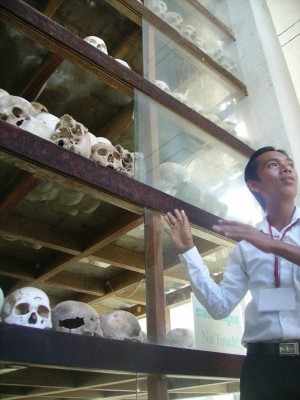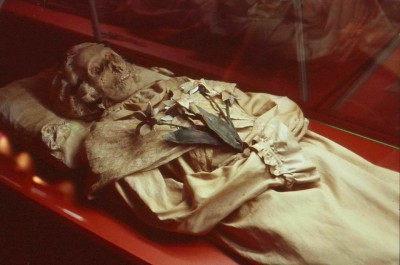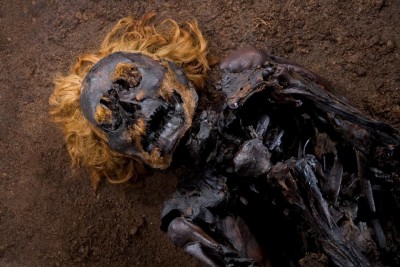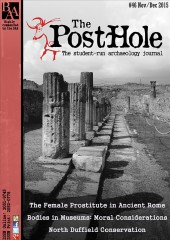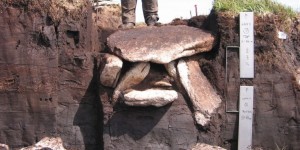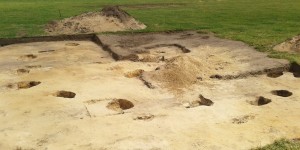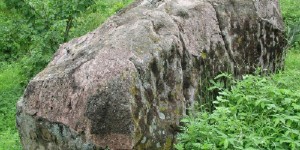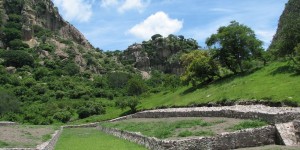Introduction
Archaeologists frequently come into contact with human remains. However, issues regarding the treatment of the dead, whether through scientific investigation or display, remain contentious topics. In this essay, I will attempt to summarise the broad theoretical discourse regarding the moral concerns over the treatment of the dead and the display of human remains in museums. I will first address the two opposing world views that affect how various groups interpret and respect the dead, identifying the dualistic and materialistic scientific community on the one side, animistic indigenous communities and pagan groups on the other. Due to the sensitive nature of the subject in my reflection on the topic I shall discuss two other issues concerning the dead, these include the circulation of their photographs online and in the media, as well as the relationship between tourists and displayed human remains.
Are human remains ‘Persons’ and is it necessary to display human remains?
(Current debates)
More than a 130 museums in Britain hold in their care large quantities of human remains, the Natural History Museum, London, has over 20,000 remains alone (Brooks and Rumsey, 2007). In 1998, the Museum of London held an exhibition entitled London Bodies, showcasing a large collection of more than 18,000 human skeletal remains from the museum’s archaeology department (Swain, 2002, p98). The purpose was to reveal how Londoners have changed in appearance through time, with reference to the archaeological record (ibid. p98). Similarly, in 2007 the Manchester Museum hosted their exhibition, Lindow Man: A Bog Body Mystery, for the third time, due to its popularity (Alberti et al. 2009).
There are a number of moral and ethical questions which must be addressed by researchers and museum staff in their everyday encounter with the dead. These questions concern the moral duties of archaeologists, the way in which the dead are ‘wronged’, and how museums should store, handle and display human remains.
How do we respect the dead? There are two valid standpoints here, some of the communities from which remains are said to have originated argue for their repatriation and reburial instead of being in display cases in institutions. Archaeologists, on the other hand, argue the importance of analysing human remains, but with a degree of ‘respect’ guided by their code of ethics. We see that respect is a matter of relativity in this case.
Beinkowski (2006) sees it essential for archaeologists to delve into the various attitudes that we hold towards mind, body and consciousness. This is because of the importance in the relationship between these, in terms of the core role that it holds in understanding the world view of the culture at hand, and their attitudes towards the dead. There are four basic world views, the first of which is dualism (Beinkowski, 2006). French philosopher Rene Descartes explicated that human beings have two separate substances, Mind and Body. This view had a key role in the enlightenment, and from the 17th century impacted the development of science, guiding the disciplines of archaeology and museology. The second is materialism, where only Body or Matter exists. There is a claim that this has led to philosophy and science becoming increasingly materialist, a trend continuing today. Thirdly is idealism; only mind or spirit exists, everything else being an illusion. This world-view is considered to have been largely ignored by contemporary western philosophy and science. Finally, animism: Mind and Matter always go together and everything is simply part of Nature (Beinkowski, 2006). Indigenous cultures and pagan groups fall into this category (Alberti et al. 2009; Bain and Wallis 2006). Pagans are coined as ‘new indigenes’ by Bain and Wallis (2006, p4) due to their shared world views with indigenous peoples, ‘whose re-enchantment practices involve engaging with nature as alive with spirits… multiple deities and other beings‘ (ibid. p4).
The idea of personhood and the lack of it are also quite important. Philosopher Immanuel Kant argued that personhood exists with consciousness and the capability to make choices (cited in Beinkowski, 2006). With this comes rationality, dignity, respect and rights (ibid.). In the dualistic and materialistic world view, the dead are separated from the living, resulting in human remains being viewed as ‘things’. ‘Things can legitimately be used as means to human ends in a way in which ‘persons’ cannot’ (Beinkowski, 2006, p6). For Kant, because things have no autonomy, they are objects rather than subjects (ibid.). Because of this, ‘archaeology, as an archetypal dualistic/materialistic practice, treats dead bodies as ‘things’, for its own ends. And so, on the whole, do museums’ (Bienkowski, 2006, p7). At the opposite end of the extreme, animism shows no contrast between the mind and the body. Rather they are one, in unison and in harmony. ‘Sentience, or consciousness, is everywhere: within nature, within individual cohesive humans and even human cells communicate with each other…we call this ‘the integrated body’” (ibid. 2006, p6). As a consequence, death cannot separate the body from consciousness. The dead are still integrated within the community and are still considered as persons (Bienkowski, 2006, p7). Their presence is felt in the landscape and the environment.
It is through the discussions of personhood and morals that we understand the different sides of the argument, regarding how archaeologists and the scientific community view human remains in comparison to indigenous and pagan communities.
Both the scientific and academic communities have been accused of treating human remains as products, which are justifiable and reasonable objects to conduct analyses on (Alberti et al. 2009; Bain and Wallis, 2006; Orr, 2006). Human remains are studied in order to understand the pathology of past populations, cause of death, nature of the surrounding environment, and past diet, amongst other reasons (ibid.). In medical and scientific terms, the study of medieval, historic and pre-historic skeletal remains can help us prevent outbreaks of deadly diseases today, and may even occasionally assist in discovering cures.
On the other hand, many native Americans, Australian aborigines and British pagans ask that we treat human remains with respect by repatriating them and their grave goods to their original communities (Bain and Wallis, 2006; Davis, 1999). Orr (2006) argues that the remains of British druids in museums should be repatriated and interred in their original contexts or as close as possible. She believes that they are the ancestors of Britain ‘we are the same tribe’ and they should not belong to a museum case or stored in basements where they are ‘less honoured’, and ‘abandoned’ (ibid. p3- 5). Some people believe that when their ancient ancestor’s remains are removed, their tribe is torn apart and they feel ‘the disconnection’ (Orr, 2006, p3-7). When human remains are displayed they are usually shown in secular, museum based perspectives (ibid.). Hence she argues; archaeologists should think outside of their own materialistic and dualistic worldviews to understand other rationales (Orr, 2006, p6).
Scarre (2003) argues that we do not need to share the spiritual and religious beliefs of ancient peoples in order to treat remains with respect. However, some of the ways in which we treat remains may breach the wishes of the deceased. Scarre (2003, p242) suggests that, ‘it is fairly certain that an Egyptian pharaoh would not have wished to be translated from his tomb in the Valley of the Kings to a glass case in the British Museum… Ancient Egyptians took very seriously the issue of their welfare after death. For Egyptians of all ranks, one of the main tasks of this life was to make suitable preparations for the prosperity in the next…’ Some people believe tomb robbers may have disrupted their journey to the afterlife. Archaeologists, however, have scientific and academic intentions, which are deemed beneficial, but their treatment of pharaohs’ remains would still be as objectionable from the viewpoint of ancient Egyptians (ibid. p242). Therefore, in this case, respect should be considered in terms of granting the wishes of the dead, as opposed to serving the purposes of the living.
In the words of Davis (1997, p12-13), a member of the Council of British Druid Orders (CBDO), ‘every day in Britain, sacred druid sites are surveyed and excavated, with associated finds being catalogued and stored for the archaeological record. Many of these sites include the sacred burials of our ancestors. Their places of rest are opened during the excavation; their bones removed and placed in museums for the voyeur to gaze upon, or stored in cardboard boxes in archaeological archives… these actions are disrespectful to our ancestors. When archaeologists desecrate a site through excavation and steal our ancestors and their guardians…it is a theft… we should assert our authority and reclaim our past.’
On the other hand, osteo-archaeologists counter this by stating that pagan interests are a ‘threat’ to their research (Bain and Wallis, 2006, p11). Human remains are said to be safer in museums than in other grounds and that ‘it is irritating to be told how to do one’s job by people who know little about it’ (ibid. p12). By excavating and analysing human remains, we give them back their identities and allow their stories to be remembered by future generations. For Davis (2006, p3), speaking on bog bodies of Iron Age Britain and northern Europe who were sacrificed, excavation and analysis is an opportunity to give a voice to the past, to those ‘who can no longer speak’. It is ‘examining the actual materials from the period that expands our knowledge’ of the past; this cannot be deduced from documents and archives (ibid.). But, he argues, we can do this with a degree of respect towards the dead. To rebury human remains, such as bog bodies, without first being allowed to extract information is to lose a part of history that we can never get back (Giles, 2006).
Because of the pressure from native communities, archaeologists and investigators dealing with human remains now have a set of ethical and moral codes governing their practices, spanning from governmental legislation to archaeological and forensic governing bodies. For instance, the Guidance for the Care of Human Remains in Museums issued by the Department for Culture, Media and Sport (DCMS, 2005) provides a framework for the legal acquisition and care of human remains by museums and institutions, the curation and use of these remains (including storage, public display, and access to research and education), and their repatriation (including the process of returning remains).
In 2013, the Advisory Panel on the Archaeology of Burials in England (APABE) published guidelines for institutions wishing to carry out scientific studies on human skeletal remains, providing a framework for the destructive analyses researchers carry out. These destructive and irreversible procedures include extraction of samples from human bones and teeth for carbon and nitrogen stable isotope analyses to understand diet, strontium and oxygen isotope analyses for tracing geographic origins, DNA analyses to shed light on ancient diseases, and radiocarbon dating to provide an absolute date. The APABE believes that studying human remains provides a beneficial insight into human history; despite the irreparable damage caused by the analysis of bone.
Therefore, archaeologists need to evaluate their research and decide if it will have positive results; ‘whether that knowledge could be obtained by non-destructive analyses [if possible], the experience and competence of those who intend to undertake the work’ and ‘the feasibility of the techniques’ are a few of the many considerations researchers are made aware of (APABE, 2013, p2-5). If the sampling is approved then the processes should be “properly documented” for future researchers (ibid. 2, 6). In short, as long as the results are positive and outweigh the destructive sampling techniques, we should conduct scientific research on human remains provided that we treat them with appropriate respect.
Why should museums display the dead?
Displaying human remains in museums and temporary exhibitions, inspires young people in science, and creates interest in the study of human bodies. Alberti et al (2009, p135) states that, ‘when small children and younger adults actually experience captivating displays, their interest is piqued, their intellect stirred, perhaps a life-long exploration begins. Such displays therefore act as ‘advertisement’ for the next generation of eminent physicians and anti-cancer researchers’.
Giles (2006, p2-3) argues that ‘it is the experience of coming ‘face-to-face’ with the past, which museum displays…attempt to capture.’ It is, therefore, the reason why many visit museums. As with bog bodies, they cannot be easily reinterred because their original contexts may have been destroyed. Since their possible living descendants could be traced narrowly, Giles suggests that they be displayed in museums ‘with sufficient respect present with various interpretations’ (ibid. p11). As archaeologists, our task is to foster greater understanding of the past, and telling the stories of bog victims is one way to do so.
It is argued that as well as conducting scientific analyses on human remains, displaying the dead is also treating them as things. ‘We put them into a particular context, with restricted information that is carefully chosen to interpret the dead body for our own contingent purposes’ (ibid. p137). Brooks and Rumsey (2007, p261) argue that human remains are ‘contextualised’ in museums through their exhumation and placement into a new context. The dead now have a ‘different function’ of serving the interests of the present, through their use in our educational efforts and to further our knowledge of human past. The Human Tissue Act (2004) states that human remains should be ‘treated with appropriate respect and dignity’, but how can we achieve this when we use them as “objects, for our own purposes and needs, irrespective of the wishes of the dead?’‘ (Alberti et al. 2009, p138). Cole (2000, p169) contends that human remains are ‘relics of once vital individuals, which do not belong in a museum setting but rather in a memorial setting’. Displaying them runs ‘the very real risk of creating a cabinet of horrible curiosities’.
Although the public may gain new insight from viewing human remains in museums, it is not necessary to showcase (Alberti et al. 2009, p138). Tarlow (2006) argues that a degree of privacy should be afforded them, especially considering cases in which naked bodies are on public display and thus open to criticism. The decision to showcase human remains is made with dualistic and materialistic institutions and scientific communities holding the most influence. As a result, the wishes of the deceased and their communities are often overlooked. For example, Charles Byrne (O’Brien), ‘The Irish Giant’, wished his body to be buried in the sea, but the Hunterian Museum continues to display his remains, refuting that his will was not written in paper and that he serves to educate present and future generations about the conditions of giant peoples (Alberti et al. 2009, p140).
My personal standpoint and reflections upon the issue
What is the difference between displaying human remains in museums and disseminating their photographs in the media and online? Moral and ethical issues are particularly sensitive when considering the treatment of the skeletal remains of those who died violent deaths. For instance, skeletal remains of more than 8,000 people who died in the recent Cambodian genocide from 1974-1979, are displayed in the Choeng Ek memorial in the middle of the killing fields.
Most of the readings on archaeological treatment of human remains concern the ethical and moral issues of their display in museums. However, many of their images circulate on the internet and are present in archaeological and historical journals and magazines, as well as in newspapers, which tend to reach out to a wider audience than museum visitors. Media coverage is more widespread in our society and influential than museum displays. Should we be concerned with the circulation of images of the dead in the media? I believe this is a very important issue, and that we should consider the same ethical and moral issues as when we display the dead in institutions. Foremost of these is that the dead would likely not consent for their remains to be photographed and viewed across so many platforms open for wider public opinion, especially given that many people viewing these images may make disrespectful comments.
On 10th April 2015, the Archaeology Magazine posted a photo of a Hungarian mummy, indicating that it was a victim of tuberculosis (see fig. 1). At the time of writing, there are over 9,000‘likes’ and over 1,000‘shares’. Nine days later a photo of ‘Red Franz’, a bog body from Germany, was posted in their Facebook page (see fig. 2).
There are currently 14,019 ‘likes’ and 2,956 ‘shares’. A link to the original article on the web called Bog Bodies Rediscovered was provided with the photo of ‘Red Franz’, which showcases some of the most striking images of bog bodies discovered in northern Europe (Lobell and Patel, 2010). These sensitive images often end up in the layperson’s Facebook ‘newsfeeds’ across the world in various contexts. Some Facebook users have already posted inappropriate comments online such as ‘that’s the Ghost Rider, right?’, ‘I SWEAR I saw this guy in the parking lot of a Greatful Dead concert’ and “this is how the zombie apocalypse starts” (Archaeology Magazine, 2015a; ibid. b).
The Archaeology Magazine, a reputable source of information on archaeological developments throughout the world, published by the Archaeological Institute of America (AIA), has over a million Facebook ‘likes’. Their Facebook page offers easy access to archaeology news, which is automatically updated in the subscriber’s newsfeed. A lot of people may be unaware that their jokes can be seen as disrespectful, but some groups do believe that these remarks are highly insulting to the deceased. Though social media can inform people about human history, circulating graphic images of the dead, especially close-ups, can facilitate disrespect.
Most ethical and moral debates centre on archaeological human remains. Remains from recent atrocities and genocide are rarely taken into consideration but are of great historical significance. I am particularly concerned with places which hold and display multiple human skeletal remains. For instance, the Choeung Ek Genocidal Centre holds more than 8,000 skulls on eight different levels, indicating the type of death they suffered. Partially excavated by archaeologists in the 1980s, the site is a major tourist destination in Phnom Penh, Cambodia, visited by thousands of foreign and domestic travellers each year (CEGC, 2012). Many skeletal remains are still scattered across the site and can be stepped on and freely touched by visitors. Visitors are charged $6, which includes an audio tour or a local guide tour. The experience takes many visitors back through time and having been there myself, I can say it is very informative.
I was interested in visiting Choeung Ek because I had just finished my history module on South-East Asia during the Cold War at school. Thus, I was aware of the history of site and the atrocities committed. People visit Choeng Ek for various reasons, but I’m concerned that many visit to experience a different kind of dark, ‘fear-related’ tourism, exemplified by trips to scary themed parks. Many would argue that experiencing Choeung Ek has opened their eyes and made them respectful of the Cambodian people. However, some are not so respectful. On TripAdvisor (2015), there are over a thousand photographs posted by foreign visitors, including a couple of ‘selfies’ with the skeletal remains. These images could be posted on their social media profiles, exposing the remains to further ridicule.
It is human nature to be curious and to have an interest in the past, but I believe that these acts do not show respect to the dead but instead expose the victims of horrendous crimes to unhealthy fascinations. I believe that displaying the dead in this way is ethically and morally wrong, considering their death at the hands of the Khmer Rouge regime. Their story should not be exploited and trivialised by ‘morbid’ tourism. Over 5,000 people reviewed the site and although most comments contain the word ‘sad’ many recommend the ‘attraction’ (TripAdvisor, 2015). Tourists who visit Choeung Ek Genocidal Centre also stopover at the Killing Fields Museum of Cambodia, located at the S-21 Prison, where people were interrogated and tortured before being massacred in masses at Choeung Ek. It could be argued that the victims of Pol Pot’s genocide have merely been reduced to and marketed as an activity for those seeking a macabre thrill.
Although I feel affected when I see images of any human remains, whether a complete body or just body parts, I think archaeologists have a duty to help us understand humanity’s past and where we could be heading in the future. However, to display bodies in museums carries many ethical and moral issues, as does displaying photographs of human remains. Who authorises which human remains should be exposed to public light and criticism? By displaying human remains, the dead are merely becoming commodities to sell archaeology. We deny them humanity and privacy.
Conclusion
Though an exhaustive topic, I have highlighted important debates regarding human remains and their display, including the various stances on respectful treatment of the dead. I have presented various examples of the exhumation of human remains as well as arguments for their reburial and repatriation. I have given my view and reflected on other issues arising from the debates, such as the circulation of images of the dead online and in the media, and the relationship between displaying victims of atrocities and tourism.
With regards to the scientific analyses of human remains, I am personally against this. I believe that it is disrespecting the right of the dead to rest, such as in the case of the victims of the Cambodian genocide. However, as an archaeologist, our goal is to foster greater understanding of the human past. Sampling techniques extract portions of bones, teeth and burial materials that are irreplaceable. Even though these will give us a better understanding of who the person was, some would argue that removing parts of the bone are disrespectful. The wishes of the dead and their peaceful reburial should therefore be afforded them. As archaeologists, we are forcing our materialistic values onto our subjects when we analyse them. In this regard, based on the debates mentioned, I disagree with the idea that the dead are merely objects for the researcher rather than persons with the right to be left alone to rest. The display of human remains is a contentious issue, but different groups should accept a healthy dialogue to move forward.
Bibliography
- Advisory Panel on the Archaeology of Burials in England (2013). Science and the Dead. A Guideline for the Destructive Sampling of Archaeological Human Remains for Scientific Analysis. English Heritage Publishing.
- Alberti, S. J. M. M, Bienkowski, P, Chapman, M. J. and Drew, R. (2009). ‘Should we Display the Dead?’, Museum and Society, Vol.7(3), p133-149.
- Brooks, M. M. and Rumsey, C. (2007). ‘The Body in the Museum’ in Human Remains: Guide for Museums and Academic Institutions (eds.) Cassman, V. Odegaard, N. and Powell, J. Oxford: AltaMira Press.
- Cole, T. (2000). Selling the Holocaust: From Auschwitz to Schindler, How History is Bought, Packaged and Sold. London: Routledge.
- Davis, P. (1997) ‘Respect and Reburial’ in The Druid’s Voice: The Magazine of Contemporary Druidry Vol. 8 (summer), p12-13.
- Davis, P. (1998/9). ‘Speaking for the Ancestors: The Reburial Issue in Britain and Ireland in The Druid’s Voice: The Magazine of Contemporary Druidry Vol.9 (winter), p10-12.
- Department of Culture, Media and Sport (2005). Guidance for the Care of Human Remains in Museums London: DCMS.
- Scarre, G. (2003). ‘Archaeology and Respect for the Dead’ in Journal of Applied Philosophy Vol. 20, p 237-249.
- Swain, H. (2002). ‘The Ethics of Displaying Human Remains From British Archaeological Sites’ in Public Archaeology Vol. 2, 95-100.
- Tarlow, S. (2006). ‘Archaeological Ethics and the People of the Past’ in Scarre C. and Scarre, G. (eds.) The Ethics of Archaeology: Philosophical Perspectives on Archaeological Practice. Cambridge: Cambridge University Press. p. 199-216.
Online Sources:
- Archaeology Magazine (2015a) ‘Multiple strains of TB have been detected in eight naturally mummified bodies from a 2000-year-old Hungarian crypt’ in Facebook Posted in 10 April 2015,https://www.Facebook.com/archaeologymag/photos/a.10151463027509795.10737... [accessed 10 April 2015]
- Archaeology Magazine (2015b) ‘From the Archive: Discovered in Germany, “Red Franz” is one of dozens of bog bodies from northwestern Europe that gives us a direct look at life in the Bronze and Iron Ages’ in Facebook Posted in 19th April 2015.
https://www.Facebook.com/archaeologymag/photos/a.10151463027509795.10737... [accessed 19 April 2015] - Bain, J. and Wallis, R.J. (2006) ‘The Sanctity of Burial: Pagan Views, Ancient and Modern’ in Respect for Ancient British Human Remains: Philosophy and Practice conference proceedings at the Manchester Museum. http://www.museum.manchester.ac.uk /aboutus/ourpractice/respect/fileuploadmax10mb,136200,enpdf [accessed 3 May 2015].
- Beinkowski, P. (2006). ‘Persons, Things and Archaeology: Contrasting World-Views of Minds, Bodies and Death’ in Respect for Ancient British Human Remains: Philosophy and Practice conference proceedings at the Manchester Museum,
http://www.museum.manchester.ac.uk/media/cultural/museum/migration/thema..., [accessed 3 May 2015]. - Choeung Ek Genocidal Centre (CEGC) (2012).
http://www.cekillingfield.org/index.php/en/about-us/choeung-ek-genocidal...
[accessed 5 May 2015]. - Human Tissue Act (2004). Office of Public Sector Information c.30,
http://www.legislation.gov.uk/ukpga/2004/30/contents [accessed 3 May 2015]. - Giles, M. (2006). ‘Respect for Ancient British Human Remains: Philosophy and Practice’ in Respect for Ancient British Human Remains: Philosophy and Practice conference proceedings at the Manchester Museum, http://www.museum.manchester.ac.uk/media/cultural/museum/migration/thema... [accessed 3 May 2015].
- Lobell, J.A. and Patel, S.S. (2010). ‘Bog Bodies Rediscovered. True Tales From the Peat Marshes Of Northern Europe’ in ARCHAEOLOGY Vol. 63(3),
http://www.archive.archaeology.org/1005/bogbodies/ [accessed 19 April 2015] - Orr, E.R. (2006). ‘Human Remains: The Acknowledgement of Sanctity’ in Respect for Ancient British Human Remains: Philosophy and Practice conference proceedings at the Manchester Museum,
http://www.museum.manchester.ac.uk/media/cultural/museum/migration/thema... [accessed 3 May 2015]


